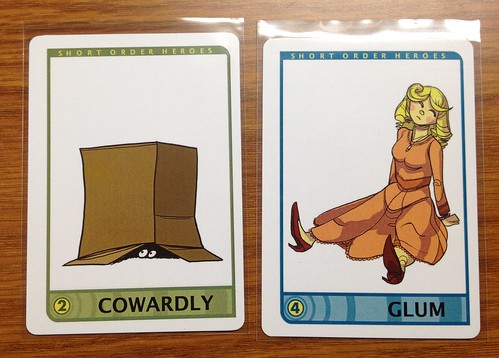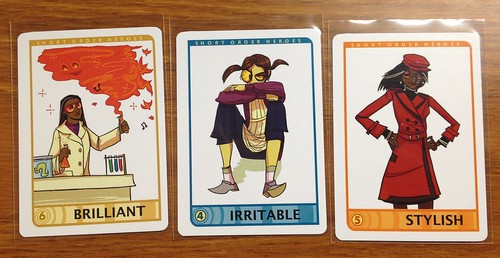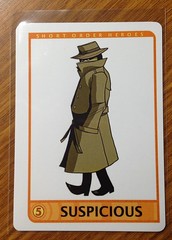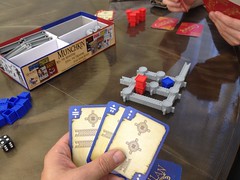For the Lego Fans
Yes I know it has been a while since I have done a review (and a while since before the last one as well). Well for you I am sorry to say this update is singularly almost singularly about Kickstarters. but I do have some treats for you. I have been working on a project to code and sort Cuusoo projects (the current reason why I am behind in my reviews). It is in beta like so many of my other tools but you can go ahead and try them out:
I will have some more articles and updates in the next few days.
Now, on to...
Austin Board Game Bash Review (Part I)
One very interesting thing about this year's event was that we had five (at least) kickstarters in attendance (although I must admit that I brought 3 of them myself):
- Ogre 6E Designer Edition of Steve Jackson Games
- Dragon Whisperer of Albino Dragon Games
- Teramyyd:Earthsphere Beta by IO Worlds
- Short Order Heroes by Calicogames's
- Mobile Frame Zero by Joshua A.C. Newman and Vincent & Sebastian Baker
Steve Jackson Games
I have gotten a chance to see some of the early production on Ogre before and with the limited time available to me I decided to wait until the Ogre Launch Party to really sink my teeth into this game. I was however able to flip through the new Munchkin Pathfinder deck. The deck was everything you expect from Munchkin: Great puns, Humorous John Kovalic art, and the kind of content that tells you SJG loves the theme just as much as you do.I finally got to play Castellan though which was one of the event highlights for me. Like many of my favorite games the basic rules are simple but the strategy is complex.
 In this game you are trying to build a castle. The parts of the game are towers with joiner elements, short walls, and long walls. In addition to these you have player markers that are blue or red (there are also green and yellow for four player expansion).
In this game you are trying to build a castle. The parts of the game are towers with joiner elements, short walls, and long walls. In addition to these you have player markers that are blue or red (there are also green and yellow for four player expansion).Each player has two decks of cards and you start the game by drawing four card from either deck. Each card shows an assortment of castle elements and perhaps a "draw a card" icon. On your turn you play as many cards as you like from your hand, drawing from the parts bank all the depicted elements from any card played.
You then link your element to a constantly expanding castle. Your intent is to make complete loops. Each time your placement of a piece makes a complete loop you put a colored marker in the loop representing that it is yours. At the end of the game each loop you have claimed will give you one point for every tower in the loop.
Once, and only once during the game, when claiming a loop you may place two markers in the loop, one on top of the other. At the end of the game, this loop will give you double points.
 When your turn is over you draw one card back into your hand as well as an additional card for each "draw a card" icons you played. If the geometries of the board leave you with extra pieces you cannot place, you forfeit them to your opponent.
When your turn is over you draw one card back into your hand as well as an additional card for each "draw a card" icons you played. If the geometries of the board leave you with extra pieces you cannot place, you forfeit them to your opponent.It is important to note that you, and only you, may play additional pieces into loops that you have closed off. Thus you will want to make your loops expansive enough that you can add more towers in later or allow the loops to be sub-divided to add even more points.
The basic game is simple, but constructing a layout that shuts out your opponent while maximizing your future advantage is delightfully tactical.
Dragon Whisperer
I accidentally missed this kickstarter so I was very excited to see this at ABGB. You can see a video of the rules here but I will do my best to describe them here.The intented purpose of Dragon Whisperer is to serve as a quick pick-up game and I find that it matches that role quite expertly with simple rules, quick setup, and engaging enough to have a lot of replay value.
The game at its core is a trick taking game. There are some ingenious twists though that breath a lot of life and strategy into the game making it a very novel experience and preventing players from feeling helpless if they don't end up with a whole bunch of "face cards" like you might in a more traditional game. The rules look a bit daunting at first but you will have it down by the end of the first deal. What takes time, is mastering the game though as its strategy unfolds to you as you play, which in my mind is always a hallmark of a great game.
Elements

The "suits" of the cards are distinguished by color and their numbers ranges from 1 to 7 with 7 being the highest card of any suit. In addition to the number cards there are a few "Dragon Rage" cards in the deck, which I will explain later. The other parts of the game are a board showing the seven suits, seven sets of "quest" tokens values from 1 to 5 (one set for each color suit), a pile of monster tokens, a pile of treasure tokens, and the first player token.
Setup
The first step in setting up the game is deciding the number of players. You vary the number of suits in play with the number of players. For the four player game I tried, we used five suites. For suit, a stack of randomly ordered quest tokens is placed at the "haven" of the appropriate color on the board. . Note that each token has a numeric value from 1 to 5 and these tokens are in random order, with their value showing. Each player is then dealt 8 cards with the remaining cards becoming the trump deck. The first card of this deck is revealed and its color is the trump color for the start of the next round.Play
The first player, the holder of the first player token, declares a haven (quest token stack) and plays a card. All other players must play in the same suit, if they have a card of that suit. If they don't have that suit they may play trump, any other suit, or a Dragon Rage card.The player that plays the highest card of the initial suit winds the trick. Unless of course a trump card is played, then it goes to the highest trump card played. In either of these two cases, the player who takes the trick also takes the top quest token from the active haven. If you take the trick with a card matching the color of the haven, you get a bonus monster token.
Now for the fun stuff that adds a lot of strategy to the game. Suit cards 1-4 and the Dragon Rage cards have special abilities which a player needs to leverage to maximize their score.
When someone plays the 1 card, they take control of the first player token. That's right, the lowest valued trick taking card gives you control of the next hand.
When the 2 card is played, the player takes a monster token from the bank. The player with the most monster tokens at the end of the game gets five extra points.
The 3 card changes the trump suit. Yeah, if you don't like the trump color, you can change it. The only problem is that it is random. You play the 3 and you have the option of drawing the next card off the trump pile and revealing the new and current trump in play.
The 4 card gives you a treasure token. Treasure tokens are worth one point each at the end of the game.
The Dragon Rage card negates the trick. If a player plays a Dragon Rage, the special abilities of cards 2,3, and 4 still function but nobody gets a quest token. As an added bonus that player also takes the first player token, trumping the ability of the 1 card.
Each time you run out of cards you reshuffle and play continues until all the quest tokens have been taken. Then the score is determined by summing up the quest tokens (by value) and the treasure tokens (one point each). As stated before, the player with the most monster tokens also gets five more points. The player with the most points, of course, wins the game.
Strategy
The brilliant aspect of the Dragon Whisperer game is really its unfolding strategy. First off, at any time, trump can change, so you can't relay on this to win a trick. Second, each trick is worth a different value. The player of the first card in the trick selects the quest token that is being played for, so if you are in control, you want to pick a high value token if you think you can take it, or a low value one if you think you are going to loose the hand. People who are not starting a hand need to be on the look out as well. It is much better to let some hands slide and save your powerful cards for taking the best Quest tokens.Also, you are not playing with a full deck, many cards are in the trump deck so your Blue 5 might be the highest Blue in play so you need to watch what comes out of the hands and the trump deck and sometimes you can push your luck.
Even when someone plays a Dragon Rage card you still get Treasure and Monster tokens so that is an obvious move when the Rage is played, but that is a rare occurrence. You need to learn to read when you have a chance of taking a trick and when you should drop one of these low cards for the long game.
All in all a fine game that is quick yet very engaging.
Short Order Heroes
 Calico Games has produced a beautiful deck of 100+ cards that is simultaneous an RPG aid and a light RPG in itself.
Calico Games has produced a beautiful deck of 100+ cards that is simultaneous an RPG aid and a light RPG in itself.As an RPG aid, the Short Order Heroes deck allows DMs to quickly add flair to any NPC by simply drawing a card or two or three.
For instance if a party should encounter a guard, instead of being a flat character, this one is also Cowardly and Glum.
This can add to any game of course but it can be very beneficial to collaborative narrative games like Fate where players are intended to play on qualities of the characters they encounter.
 Short Order Heroes can also stand as a light RPG in its own right.
Short Order Heroes can also stand as a light RPG in its own right. To create a character you simply draw three cards. In this case Brilliant, Irritable, and Stylish. These are the traits that define your character.
Now if this character were to go up against the previous guard the player and the DM collaborate. The base difficulty of any action is 4 but the PCs irritability plays off well against a cowardly guard. Also being so stylish the PC must be someone important too, not someone a cowardly guard wants to cross. So Lets say the PC has a +2 to the action bringing the difficulty down to 2.
 The DM then draws the next card from the deck and checks the number in the lower left corner. In this case the card is a Suspicious 5. The 5 is greater than the necessary 2 so the player wins the challenge and can pass the guard. The numbers by the way range equally from 1 to 6 with a 0 (Jinxed) and 7 (Lucky) thrown in for good measure.
The DM then draws the next card from the deck and checks the number in the lower left corner. In this case the card is a Suspicious 5. The 5 is greater than the necessary 2 so the player wins the challenge and can pass the guard. The numbers by the way range equally from 1 to 6 with a 0 (Jinxed) and 7 (Lucky) thrown in for good measure. The DM and PC at this point figure out how "Suspicious" plays into the events. Perhaps the PC approaches the guard demanding passage to see the guard's superiors. There are suspicious characters about that threaten the gate (and the guards!). Once inside the PC will "certainly" see to it that reinforcements are sent.
The Deck is very well drawn with a bit of a humorous inclination and is a pleasure to flip through. It makes for an entertaining evening and a great introduction to guided narratives for both young and mature audiences.

No comments:
Post a Comment